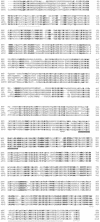The nucleotide sequence and spliced pol mRNA levels of the nonprimate spumavirus bovine foamy virus
- PMID: 9499074
- PMCID: PMC109513
- DOI: 10.1128/JVI.72.3.2177-2182.1998
The nucleotide sequence and spliced pol mRNA levels of the nonprimate spumavirus bovine foamy virus
Abstract
We have determined the complete nucleotide sequence of a replication-competent clone of bovine foamy virus (BFV) and have quantitated the amount of splice pol mRNA processed early in infection. The 544-amino-acid Gag protein precursor has little sequence similarity with its primate foamy virus homologs, but the putative nucleocapsid (NC) protein, like the primate NCs, contains the three glycine-arginine-rich regions that are postulated to bind genomic RNA during virion assembly. The BFV gag and pol open reading frames overlap, with pro and pol in the same translational frame. As with the human foamy virus (HFV) and feline foamy virus, we have detected a spliced pol mRNA by PCR. Quantitatively, this mRNA approximates the level of full-length genomic RNA early in infection. The integrase (IN) domain of reverse transcriptase does not contain the canonical HH-CC zinc finger motif present in all characterized retroviral INs, but it does contain a nearby histidine residue that could conceivably participate as a member of the zinc finger. The env gene encodes a protein that is over 40% identical in sequence to the HFV Env. By comparison, the Gag precursor of BFV is predicted to be only 28% identical to the HFV protein.
Figures







Similar articles
-
The human foamy virus pol gene is expressed as a Pro-Pol polyprotein and not as a Gag-Pol fusion protein.J Virol. 1996 Feb;70(2):1033-40. doi: 10.1128/JVI.70.2.1033-1040.1996. J Virol. 1996. PMID: 8551561 Free PMC article.
-
Genomic organization and expression of simian foamy virus type 3 (SFV-3).Virology. 1992 Feb;186(2):597-608. doi: 10.1016/0042-6822(92)90026-l. Virology. 1992. PMID: 1310187
-
Comparison of the complete sequence of feline spumavirus with those of the primate spumaviruses reveals a shorter gag gene.J Gen Virol. 1997 Oct;78 ( Pt 10):2549-64. doi: 10.1099/0022-1317-78-10-2549. J Gen Virol. 1997. PMID: 9349476
-
Non-primate foamy viruses.Curr Top Microbiol Immunol. 2003;277:197-211. doi: 10.1007/978-3-642-55701-9_9. Curr Top Microbiol Immunol. 2003. PMID: 12908774 Review.
-
Human foamy virus: an underestimated neuropathogen?Brain Pathol. 1992 Jan;2(1):61-9. Brain Pathol. 1992. PMID: 1341948 Review.
Cited by
-
Foamy viruses are unconventional retroviruses.J Virol. 1999 Mar;73(3):1747-55. doi: 10.1128/JVI.73.3.1747-1755.1999. J Virol. 1999. PMID: 9971751 Free PMC article. Review. No abstract available.
-
Complete genome sequences of two novel European clade bovine foamy viruses from Germany and Poland.J Virol. 2012 Oct;86(19):10905-6. doi: 10.1128/JVI.01875-12. J Virol. 2012. PMID: 22966195 Free PMC article.
-
Characterization of a full-length infectious clone of bovine foamy virus 3026.Virol Sin. 2014 Apr;29(2):94-102. doi: 10.1007/s12250-014-3382-5. Epub 2014 Mar 3. Virol Sin. 2014. PMID: 24643936 Free PMC article.
-
The Unique, the Known, and the Unknown of Spumaretrovirus Assembly.Viruses. 2021 Jan 13;13(1):105. doi: 10.3390/v13010105. Viruses. 2021. PMID: 33451128 Free PMC article. Review.
-
Bovine Foamy Virus: Shared and Unique Molecular Features In Vitro and In Vivo.Viruses. 2019 Nov 21;11(12):1084. doi: 10.3390/v11121084. Viruses. 2019. PMID: 31766538 Free PMC article. Review.
References
-
- Amborski G F, Lo J L, Seger C L. Serological detection of multiple retroviral infections in cattle: bovine leukemia virus, bovine syncytial virus, and bovine visna virus. Vet Microbiol. 1989;20:247–253. - PubMed
-
- Appleby R C. Antibodies to bovine syncytial virus in dairy cattle. Vet Rec. 1979;105:80–81. - PubMed
-
- Bartholoma A, Muranyi W, Flugel R M. Bacterial expression of the capsid antigen domain and identification of native gag proteins in spumavirus-infected cells. Virus Res. 1992;23:27–38. - PubMed
-
- Bothe K, Aguzzi A, Lassmann H, Rethwilm A, Horak I. Progressive encephalopathy and myopathy in transgenic mice expressing human foamy virus genes. Science. 1991;253:555–557. - PubMed
Publication types
MeSH terms
Substances
Associated data
- Actions
- Actions
LinkOut - more resources
Full Text Sources
Research Materials

